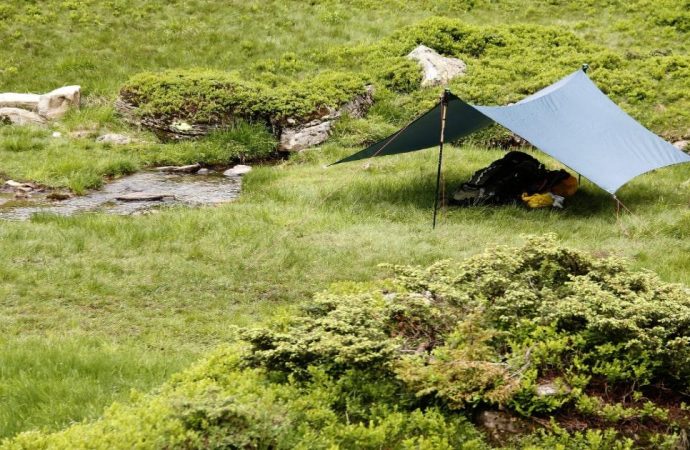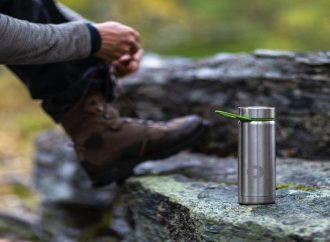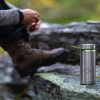When you’re in a disaster scenario, you have to make compromises, and use what you can. In short, preppers need to find more advantages in fewer things. Whether that’s eating smaller meals, wearing the same clothes repeatedly or breaking normal-world rules like re-using plastic water bottles, it’s important to think creatively. That includes the things
When you’re in a disaster scenario, you have to make compromises, and use what you can. In short, preppers need to find more advantages in fewer things.
Whether that’s eating smaller meals, wearing the same clothes repeatedly or breaking normal-world rules like re-using plastic water bottles, it’s important to think creatively. That includes the things you use.
Plastic sheeting and tarp is one of the most common materials you’ll find lying around when SHTF, and we’re here to help you take full advantage of it.
Here’s 10 great ways you can use plastic sheeting in areas including storage, filtration and accommodation. Then read on for a further 55 ways to make the most of this humble piece of survival kit.
1. Waterproofing your shelter
The UK’s known for its rain, especially in places like Cumbria, Ireland, Scotland and Wales. If you’re bugging out, it’s absolutely essential you waterproof your shelter – and plastic sheeting is a great way to do so.
Affix it to your space with materials like nails, staples and even duct tape – most preppers would consider these essentials for a number of reasons. Make sure to do this on the inside, as external fittings can be damaged more easily, and the fastenings can come loose when exposed to the elements.
2. As a makeshift bag
This is self-explanatory. Simply move the plastic sheeting into the shape of a bag, and you’re good to go – one waterproof, fairly strong vessel for transporting things. It can be hard to repair, unless you have materials like duct tape, so try to avoid this.
It does, however, work as a good last-minute resort. This is also a great way to line a different material, as it’s waterproof and strengthens your vessel, creating a higher tolerance for weight.
3. Preserving air quality
There are very few things you can compromise on in life – and one of these is your breathing. In disaster events like nuclear attacks or supervolcano eruptions, respiration becomes one of the main areas of focus, rather than an afterthought or something you take for granted.
If you properly set up plastic sheeting throughout your shelter, you can prevent airborne toxins like dust and smoke getting into your body.
4. Making body bags
No-one wants to think about this possibility – but as you know, if a disaster situation occurs, then anything can happen. It’s also one of the most respectful ways to handle a corpse, as you’re doing everything you can to provide a traditional aspect of a ceremony.
One thing worth noting is that it requires a lot of plastic sheeting to wrap around many times, and preppers might not have this much material available to spare.
5. Trapping animals
Like making a body bag, you won’t want to think about this aspect of survival – but as Tesco isn’t open, every prepper must be ready for the possibility of killing their meals themselves.
Preppers can make simple traps to catch animals like rabbits and squirrels, and more experienced animal trappers can also use plastic sheeting to for fishes and crayfish in nearby streams. A survival fisherman can also use individual bits of ripped plastic as bait.
6. Making a shelter
We’ve already touched on using plastic sheeting to upgrade your current shelter, but it can be used independently to make a shelter by itself. As you’ve guessed, this is a good way to create an airtight, waterproof space, although it’s one of the worst long-term solutions you can choose.
For a night or two, you’ll be okay. Simply form the general shape of a shelter, secure it in place with materials or the environment around it, like tying it to trees, and you’ll have created your own temporary space.
7. Collecting rainwater
When SHTF, clean water is scarce – but thanks to the rain, you have unlimited access to a less clean alternative. Plastic sheeting is a great way to collect this. All you need to do is lay it horizontally with the corners up, the larger the surface area, the better, and let mother nature do her thing.
The water will need filtration, purification etc, but you can buy an assortment of materials and equipment to ensure this is safe for consumption.
8. Covering dirty ground
This is plain and simple – just use the sheeting as another layer between you and dirt and insects. You’re probably thinking of using it to lie on, not a bad idea, but you can also use it as a material to prepare any caught animals for your consumption. After all your efforts, you don’t want a meal consisting mostly of mud and twigs.
9. Quarantining loved ones
Depending on the disaster you’re facing, there’s a number of reasons you may need to separate yourself from those you’re with. This is especially true for groups who are bugging out, as properties used to bug in may have more than one room.
Whether you’re fighting a contagious disease, or something mild like a coronavirus, or want to stop younger survivors from seeing things they aren’t ready for, plastic sheeting is a good way to divide the group up, and protect the surrounding environment from anything that may occur within your makeshift walls.
10. Building a roof
Like waterproofing your space, this is a great way for preppers to stay away from the UK’s more challenging climates. It will act as a waterproof fixture, but it doesn’t add much security as it can’t handle much weight like falling branches.
Strong winds can also cause it to blow away – if not this, then there is still a high chance of tearing. Also use it to patch up roof leaks on your home, tent or caravan.
11. Keep Firewood Dry
Tarpaulins can be secured over your woodpile using ropes, bungee cords, or other methods to keep them in place and ensure that they are kept dry even in the worst weather.
12. Make a Solar Still
Place a container of water in the centre of the tarpaulin and place a rock or heavy object on top to create a slope. Place a clean container at the lowest point of the slope to collect purified water. Secure the corners of the tarpaulin in place and leave it in a sunny location for several hours. As the water evaporates, the vapour will condense on the tarpaulin and flow into the clean container.
13. Patch up Windows
Clean the edges of the broken window and measure the size of the opening. Cut a piece of tarpaulin to fit the opening, then attach it to the window frame using nails, screws, or adhesive tape. Alternatively, you can use bungee cords to hold the tarpaulin in place.
14. Build Your Own Greenhouse
You will need wooden poles, metal pipes, or other materials to create a frame. Cover the frame with tarpaulin and secure it in place. Make sure that the tarpaulin is tightly secured and that there are no gaps or holes that will allow cold air to enter the greenhouse. Place plants inside the greenhouse and ensure that they receive adequate sunlight and water.
15. Polytunnel
If you need a larger space to grow things, then create a long polytunnel with a metal or wooden frame. Make sure that the tarpaulin is tightly secured and that there are no gaps or holes that will allow cold air to enter the polytunnel. The tarpaulin cover will help to create a warm and humid environment that is ideal for plant growth.
16. Create Different Sized Cloches
Improve your yield of fruit and veg with a small homemade cloche. Place plants inside the cloche and ensure that they receive adequate sunlight and water. Complete regular checks to make sure no bugs have managed to get inside the cloche.
17. Solarize Your Soil
To solarize soil using tarpaulin, you will need to clear the area of weeds and debris and then moisten the soil. Cover the soil with a layer of tarpaulin and secure it in place for 4-6 weeks during the hottest time of the year. The sun’s heat will cause the soil temperature to rise, killing weeds, pathogens, and other pests that may be present in the soil. After the solarization period, remove the tarpaulin and prepare the soil for planting.
18. Create Blackout Curtains
A black tarp can cover windows to hide your presence inside. Cut the tarpaulin to the desired size, then hem or tape the edges to prevent fraying. Hang the tarpaulin curtains using a rod or other hanging method such as duct tape. The tarpaulin material is durable and will help to block out light and provide privacy.
19. Protect Plants From Frost
Cover your survival garden plants with the tarpaulin before frost is expected to occur, and secure the tarpaulin in place using stakes or other methods. The tarpaulin will help to protect the plants from frost damage by trapping heat and moisture around the plants. Make sure to remove the tarpaulin in the morning to allow the plants to receive sunlight and ventilation.20. Shade – protect plants from the heat of the sun with a white reflective tarp
20. Shade Your Survival Garden
Cover the plants with tarpaulin to provide shade and protect them from direct sunlight. Secure the tarpaulin in place using stakes or other methods. Make sure to adjust the tarpaulin as needed to ensure that the plants receive the appropriate amount of sunlight and shade. The tarpaulin will help to keep the plants cool and prevent them from overheating or drying out.
21. Build a Pond
You will need a piece of tarpaulin large enough to create the desired size and shape of the pond and materials such as soil, rocks, and plants to fill and decorate the pond. Lay the tarpaulin on a flat surface and shape it into the desired size and shape of the pond. Secure the edges of the tarpaulin in place using rocks or other materials to hold it down. Fill the pond and use it for fish or even drinking water.
22. Keep Heat In
To keep heat inside with a tarpaulin, you can use it as a makeshift tent or lean-to. You can also use it to cover windows or drafty areas or to create a windbreak. Make sure it is secured properly and sealed off around the edges to prevent heat from escaping.
23. Make a Water Scoop
To make a water scoop with a tarpaulin, you can fold the tarpaulin into a triangular or conical shape and use it to scoop water from a river, lake, or another water source. Alternatively, you can cut a section of the tarpaulin and use it as a makeshift bucket or container to transport water. Just make sure the tarpaulin is clean and free of any holes or leaks.
24. Toilet Train Pets
If you’re bugging in and can’t go outside, you can use the tarpaulin as a makeshift toilet area by placing it in an area where you want your pet to relieve itself. Make sure to praise and reward your pet when it goes to the bathroom in the designated area.
25. Privacy for Washing
In the wilderness, you may need some privacy when showering, and a tarp can be used to create a protective screen. Hang the tarpaulin from a rod or rope and use it to create a private area for showering. You can also use it to create a barrier around your outdoor shower to prevent water from getting everywhere.
26. Cover Your Latrine
To make an outdoor latrine enclosure with a tarpaulin, you can hang the tarpaulin from a frame or rope to create a private area for using the bathroom. Make sure the tarpaulin is secured properly and that there is enough ventilation to prevent odours from accumulating. 27. Warmth – place a sheet in between two sheets or blankets to keep the heat in
28. Pick Up People/Animals with a Stretcher
Cut the tarpaulin into two long pieces and use these to create the sides of the stretcher. You can then use two strong branches to attach the two sides together and create a sturdy and durable stretcher that can be used to carry injured people or animals to safety.
29. Signal for Help
You can use it as a makeshift flag by attaching it to a pole or stick. You can also use it as a reflector by attaching it to a reflective surface, such as a mirror or reflective tape. In either case, you can use the tarpaulin to signal for help or to alert others to your location. Make sure to choose a colour that is easy to see and recognize.
30. Try your Hand at Trapping
Dig a very deep hole, cover it with a tarp and leaves, and put bait in the middle so that animals fall in and can then be slaughtered for eating. You can also use it as a makeshift net by attaching it to a frame or use it to create a makeshift enclosure. In either case, you can use the tarpaulin to trap and capture small animals, such as birds or rodents.
31. Make a Quick Backpack
Fill a tarpaulin with your belongings and secure it closed. You can then use the tarpaulin to transport your stuff to a new location by carrying it on your back. Make sure to load the tarpaulin evenly and secure it properly to prevent your stuff from falling out or getting damaged.
32. Transport Animal Kills
Place your kills, such as a deer, on the tarp and drag it back to camp by holding the corners of the tarp. You can also use it as a makeshift sling by attaching it to a pole or stick. You can then use the pole or stick to lift the animal and transport it to a desired location.
33. Make a Floatation Device
Cut the tarpaulin into a large, rectangular shape and fold it in half to create a makeshift flotation device. You can then use the device to float on a body of water or to transport your kit across the water without getting it wet. Just make sure the tarpaulin is secured properly and that it can support the weight of the objects it is carrying.
34. Travel Across Water in a Raft
Use a tarp to wrap around a wooden frame to create a boat or kayak that you can use to travel in on open bodies of water. Just make sure the tarpaulin is secured properly, and consider adding flotation devices or other features to increase the stability and safety of the raft.
35. Enjoy Some Fun
Dealing with a SHTF event can be hard on kids, so use a tarpaulin to play games when you have a moment of downtime in safety. You can use it as a makeshift playing field or surface for sports or other physical activities, a prop or accessory in games or role-playing activities or as a parachute, a fort or a slip-and-slide mat.
36. Camouflage Yourself and Your Belongings
To camouflage and hide with a tarpaulin, you can use it to cover yourself or an object you want to hide. You can also use it to create a makeshift blind or shelter by attaching it to a frame or other structure. In either case, you can use the tarpaulin to blend in with your surroundings and avoid being seen.
37. Hide Objects From Sight
If you are in survival mode and need to hide your belongings from sight, then a tarpaulin can be the perfect tool. For example, a dark-coloured tarp can cover a motorcycle or your supplies, especially when you then add natural materials on top so that it doesn’t stand out to any passers-by.
38. Make a Tourniquet
Cut a section of the tarpaulin into a long, narrow strip and tie it around the injured limb above the wound. You can then use a stick or other object to twist the tourniquet and apply pressure to the wound. Make sure to tie the tourniquet securely and check it regularly to ensure that it is not too tight or too loose. You should only use a tourniquet as a last resort
39. Glue Broken Items Together
If you need a quick way to stick things together, then a tarpaulin can help. Start by melting small pieces of your plastic tarp and then attaching them to the items that need to be bonded together. Hold firmly until the tarp glue sets, and you’re good to go!
40. Save Water for Use Later
If you are in an area with little to no water, then line a receptacle with a large tarpaulin and fill it with water that you can use later. If you have to move on quickly, you can use the water you’ve saved to fill bottles to take with you.
41. Make a Waterproof Poncho
You can cut the tarpaulin into a large, rectangular shape and fold it in half to create the body of the poncho. You can then use any sharp tool to create holes for the head and arms. You may also want to consider adding additional features, such as a hood or a drawstring, to make the poncho more functional and comfortable to wear when it rains.
42. Build a Hunting Shelter
Cover a frame or other structure to create a makeshift tent or enclosure. You can also use it to create a windbreak or to cover a tree stand or other hunting platform. Just make sure to cover the shelter with natural materials to help it blend into your environment.
43. Take a Dip in a Pool
Cool down in hot weather by making your own small swimming pool. Cut a tarpaulin into a large, rectangular or circular shape and use it to create a makeshift pool liner. You can then use the liner to create a temporary pool by filling it with water and setting it up in a desired location. Just make sure the tarpaulin is secured properly and that it is able to support the weight of the water.
44. Rest on a Pillow
If you are keen to enjoy a comfy nap, then use your tarp to make a pillow. Roll it up and use a piece of material, such as a t-shirt, to cover it so that you can relax and rest before heading off on your next mission.
45. Keep Shoes Dry
Whether you are walking in the rain or moving along the edge of a river or other body of water, you can make your shoes instantly waterproof by covering them with a tarp. Wrap the tarp around your footwear and seal it with duct tape for the driest results.
46. Wash Yourself Clean
Keeping clean is important when you are in survival mode, as you are less likely to develop any unpleasant illnesses. Make a bath with a tarp by digging a hole and using the sheet to line it before filling it with water and jumping into the tarp bath.
47. Create Seat Covers
Measure the dimensions of the seats that you want to cover and cut the tarpaulin into appropriate-sized pieces. Use a fastening method to attach the tarpaulin pieces over the top of the seat fabric, being careful to smooth out any wrinkles or creases. The tarpaulin seat covers can be used to protect the seats from wear and tear or to provide a more comfortable seating surface.
48. Mixing Building Materials
You can mix mud and cob for your makeshift shelter on a laid-out tarp to ensure the best consistency and to make usage easier than before. Make sure that you don’t overload your tarp, instead opting to mix and use small amounts at a time for the best results.
49. Protect Your Food
Take a piece of tarp and secure it around the food you want to protect from animals, and use cords to suspend the tarpaulin and container from a tree branch or other sturdy support, forming a hanging food storage unit. The hanging food storage can be used to keep food out of the reach of animals or to keep it fresh and protected from the elements.
50. Make Sailing Easier
Catch the wind on your boat or canoe by making or replacing a broken sail with a tarp. Cut the tarp into the sail shape you need and then attach the sail to a mast or other support, using a series of loops or grommets to hold the sail in place. The tarpaulin sail can be used to propel a boat or other watercraft through the water using the wind.
51. Towing Your Vehicle
If your vehicle breaks down during a SHTF event, you will need to move it quickly to avoid detection. Twist a sheet many times over into a rope, and it will be strong enough to pull a car to your desired location.
52. Keep Items Cold
If you are out hunting on a hot day, you will need to use your tarp to keep your kills cold until you can prepare and cook them. Lay your tarpaulin out and put your kills on it along with ice packs or water and wrap them up to keep them cold.
53. Stay Clean Shooting
Keeping your shooting skills at their best requires lots of practice in all types of weather. If it is wet or icy, lay a tarpaulin out on the ground and use it for shooting practice, so you don’t get dirty while you enhance your skills.
54. Haul Heavy Items
If you need to carry things from your garden, load up a tarp and drag it to make it easier to move. Remember that you will need to pull the corners together to move it, so do not overfill it before attempting to move it.
55. Keep Your Project Materials Dry
Being able to build items on the hop will require you to stockpile building materials that you may need to keep dry. Take items such as cement, sand and logs and cover them with tarpaulin before securing the tarp down so that it is ready to use in any weather.
56. Protect Animal Food
Cut tarpaulin into a rectangular shape that is large enough to fit over your animal food supply. Use the cords or ropes to secure the tarpaulin in place over the container, forming a cover. The cover can be used to protect the animal food from the elements, such as rain or snow, and can also help to keep pests out of the food.
57. Create a Booby Trap
Stay extra protected by digging a hole, putting spiked branches at the bottom, and then covering it with a tarp and leaves to make your own booby trap. This trap can be used to catch animals or give your outdoor shelter extra layers of security.
58. Make a Food Strainer
Cut the tarpaulin into a circular shape that is large enough to fit over a pot or other container. Use a sharp item to poke holes over the tarp to let water escape. Finally, place the tarpaulin over the pot and secure it in place using a rubber band or other flexible material. The tarpaulin strainer can be used to strain out solids from liquids when cooking or preparing food.
59. Protect Fire with a Windbreak
Stretch tarpaulin out between a number of branches and secure it in place using cordage or rope. The windbreak should be tall enough to provide protection from the wind and should be angled slightly to allow the wind to pass over it. Finally, anchor the windbreak in place using sandbags or other heavy objects to keep it from blowing away. The windbreak can be placed around an outdoor fire to protect it from the wind and help it burn more efficiently.
60. Create a Sledge
Cut tarpaulin into a rectangular shape that is large enough to fit your desired load. Attach cordage to the corners of the tarpaulin, and then use branches or poles to create a frame for the sledge. Secure the tarpaulin to the frame using bungee cords or other sturdy materials. Finally, attach handles or ropes to the front of the sledge to carry weary children on snow or make a snowy downhill descent a lot more fun
61. Shelter Your Livestock
First, find a suitable location that is protected from the elements and is large enough to accommodate your livestock. Next, stretch the tarpaulin out over a frame made from poles or other sturdy materials. Secure the tarpaulin to the frame using cords, ropes, or bungee cords. The shelter should be large enough to allow the livestock to stand comfortably,
62. Make Strong Cordage
Cut the tarpaulin into long, thin strips. Tie the strips together at one end to form a bundle, and then braid the strips together tightly. Once you have reached the desired length, tie a knot at the other end to secure the cordage. The cordage can then be used for a variety of purposes, such as tying down a load on a trailer or as a makeshift rope.
63. Protect Your Items
If you have loaded the outside of your car as well as the inside, cover all the items on top of your car with tarpaulin to protect it from the elements. Secure the tarpaulin with rope and shut the edges inside the car so that it cannot fly away as you travel.
64. Rest in a Hammock
You will need some cordage and two trees or other sturdy anchor points that are at least 10-12 feet apart. First, tie the cordage to each corner of the tarpaulin. Next, tie the cordage to the anchor points, making sure the tarpaulin is taught. Finally, lay in the tarpaulin and adjust the cordage as necessary for a comfortable and secure fit.
65. Barter for Something Else
As you’ve seen above, a tarp is an extremely valuable possession for British preppers, so why not barter one of your spare tarps for something else you need when you come across other preppers in the world? With so many great uses, you are sure to find a willing taker!
Summary
There’s a huge number of uses for plastic sheeting – as you can tell, it’s very versatile. It’s also incredibly light, practical, and simple to clean, which is why we’d consider it an essential product when SHTF.
In more extreme cases, it’s how you’ll find your next meal and help you breathe properly when air outside is contaminated.
In less intense survival situations, it’s simply a good way to keep things clean from the natural world around you.
We’ve listed 65, but you’re guaranteed to find additional uses for plastic sheeting when facing a situation that requires on-your-feet thinking.





















